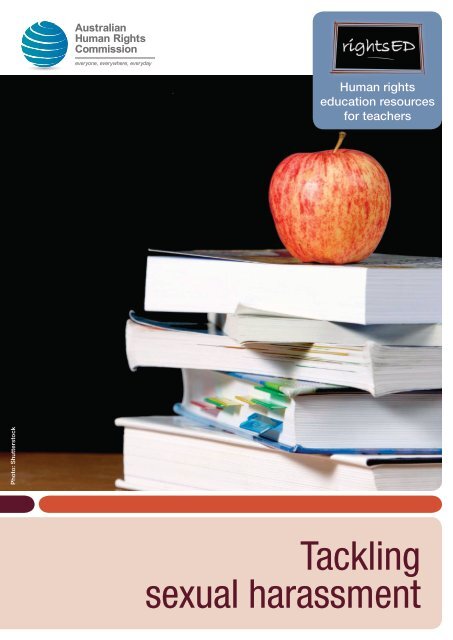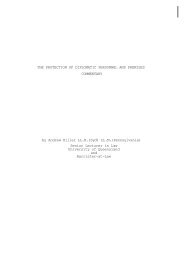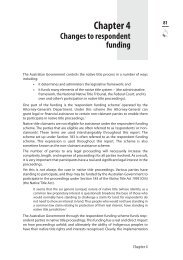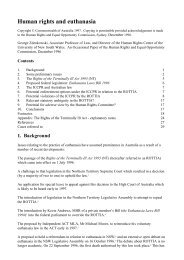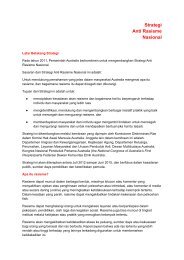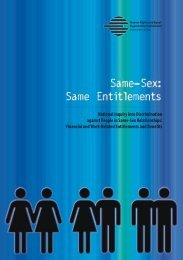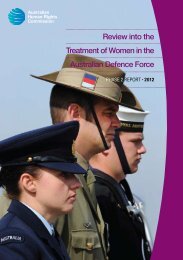Tackling sexual harassment - Australian Human Rights Commission
Tackling sexual harassment - Australian Human Rights Commission
Tackling sexual harassment - Australian Human Rights Commission
- No tags were found...
You also want an ePaper? Increase the reach of your titles
YUMPU automatically turns print PDFs into web optimized ePapers that Google loves.
ightsED | <strong>Tackling</strong> <strong>sexual</strong> <strong>harassment</strong># Statement True False16. Boys are <strong>sexual</strong>ly harassed as often as girls are.17. Sexual <strong>harassment</strong> is a form of flattery.18. It’s OK to ask a person for sex as long as you accept their answer.19. Sexually explicit jokes can be <strong>sexual</strong> <strong>harassment</strong>.20.Rude gestures are not <strong>sexual</strong> <strong>harassment</strong>, you have to actually touchor say something to another person.21. Teachers can be <strong>sexual</strong>ly harassed by students.22.Saying to someone ‘You’re a queer and I hope you get AIDS’ is a formof <strong>sexual</strong> <strong>harassment</strong>.23. Sexual <strong>harassment</strong> is not really serious – it’s just a bit of fun.24. Looks are OK, as long as you do not touch another person.25.The best way of stopping <strong>sexual</strong> <strong>harassment</strong> is to ignore it and it willgo away.8© <strong>Australian</strong> <strong>Human</strong> <strong>Rights</strong> <strong>Commission</strong> 2010 | www.humanrights.gov.au/education/tackling_<strong>sexual</strong>_<strong>harassment</strong>
Sexual <strong>harassment</strong> – true or false?(Answers)rightsED | <strong>Tackling</strong> <strong>sexual</strong> <strong>harassment</strong>Activity sheetCompare your true or false answers from the Resource sheet: What is <strong>sexual</strong> <strong>harassment</strong>?# True or False Comments1. False2. False3. TrueSexual <strong>harassment</strong> can be very hurtful and have long-lasting effects onpeople. It is also against the law.Sexual <strong>harassment</strong> includes sending inappropriate text messages thatwill offend or humiliate another person even if they don’t see it.Sexual <strong>harassment</strong> is against the law under the Commonwealth SexDiscrimination Act and legislation in every <strong>Australian</strong> state and territory.4. True Sexual <strong>harassment</strong> is not about mutual attraction and friendship.5. False6. False7. True8. False9. True10. TrueSexual <strong>harassment</strong> by an adult at school is against the law. Youcan have the issue dealt with under a school policy or by making acomplaint to the <strong>Commission</strong>.Sexual <strong>harassment</strong> does not need to be witnessed for a complaint tobe made and taken seriously.The Commonwealth Sex Discrimination Act covers <strong>sexual</strong> <strong>harassment</strong>in ‘educational institutions’. This means that schools have a duty toensure <strong>sexual</strong> <strong>harassment</strong> doesn’t occur.Sexual <strong>harassment</strong> is any <strong>sexual</strong> attention that is unwanted. Justbecause someone accepted this sort of attention in the past doesn’tmean that it’s ok now.Sexual <strong>harassment</strong> occurs when it could be reasonably expected thatsuch attention would make a person feel uncomfortable, humiliated orintimidated.Girls can <strong>sexual</strong>ly harass boys. Although this doesn’t happen as oftenas boys harassing girls.11. False Girls can <strong>sexual</strong>ly harass girls and boys can <strong>sexual</strong>ly harass boys.12. False13. False14. FalseThe responsibility to avoid <strong>sexual</strong> <strong>harassment</strong> is on the person doingthe harassing. You cannot use the way a person dresses as an excusefor harassing them.Sexual <strong>harassment</strong> includes <strong>sexual</strong> comments or graffiti that offend orhumiliate another person.Sexual <strong>harassment</strong> is based on the effect it has on the person beingharassed, not the intentions of the harasser.© <strong>Australian</strong> <strong>Human</strong> <strong>Rights</strong> <strong>Commission</strong> 2010 | www.humanrights.gov.au/education/tackling_<strong>sexual</strong>_<strong>harassment</strong>9
ightsED | <strong>Tackling</strong> <strong>sexual</strong> <strong>harassment</strong># True or False Comments15. True16. False17. False18. False19. True20. False21. True22. True23. False24. False25. FalseSexual <strong>harassment</strong> can have a very serious effect on people, includinghumiliation and intimidation.Complaints received by the <strong>Commission</strong> show that 95% of peoplewho are harassed are female.Sexual <strong>harassment</strong> is not about flattery. It’s happens when someone‘crosses the line’.Depending on how it’s said, requests for sex can be a form of<strong>harassment</strong>.Sexually explicit jokes, either told or sent by email, are a form of<strong>harassment</strong>.Sexual <strong>harassment</strong> is more than touching. It includes explicit gestures,comments, staring or leering and intrusive questions about a person’sprivate life.Adult students can be liable for <strong>sexual</strong> <strong>harassment</strong> against theirteachers.This could be a form of <strong>sexual</strong> <strong>harassment</strong>. However, it would becovered by laws in every <strong>Australian</strong> state and territory that protectpeople from homophobic behaviour.Sexual <strong>harassment</strong> can have serious effects on people, like makingthem avoid certain places and classes or drop out of school entirely. Itis also against the law.There is no one ‘right’ way to deal with <strong>harassment</strong>. However, thereare probably more constructive ways to deal with <strong>harassment</strong> thantrying to ignore it.Sexual <strong>harassment</strong> includes staring or leering that makes anotherperson feel uncomfortable and intimidated.Let’s start thinking about your school. Imagine that you heard the comments and saw the incidents onthe next page. Would they be examples of ‘<strong>sexual</strong> <strong>harassment</strong>’?10© <strong>Australian</strong> <strong>Human</strong> <strong>Rights</strong> <strong>Commission</strong> 2010 | www.humanrights.gov.au/education/tackling_<strong>sexual</strong>_<strong>harassment</strong>
Comments in the schoolyardrightsED | <strong>Tackling</strong> <strong>sexual</strong> <strong>harassment</strong>Activity sheet# Is this an example of <strong>sexual</strong> <strong>harassment</strong>? Yes No1.2.3.“What they’d do was get a ruler and try to stick it up yourskirt. They’d do it all the time. It was so bad that I wasbegging the teachers to let me go to another class.”“I was sitting in the classroom and this boy walked behindme and shouted right in my ear: ‘UGLY’. Then he kept onwalking.I was so shocked. I left the room, I couldn’t cope. At thatage you’re going through a vulnerable period – so that justcrushed me.”A girl approaches a group of girls. They turn away andignore her, and exclude her from their group, saying “Wedon’t want a lezzo like you with us”.Don’tknow4.5.6.7.8.9.10.A boy calls a girl over to his locker. He shows her a picture ofa naked woman. The girl looks and then walks quickly away.A boy and a girl are hugging each other. She laughs and tellshim that he’s only after one thing. He laughs, pulls her closerand kisses her. It is clear that they like each other.A boy bumps into a girl and then brushes against her front,but it seems to be deliberate because he’s done it to herbefore. She reacts sharply and pushes him away. He laughsand says, “It was only an accident”!“Look, we have this teacher and he doesn’t really doanything, it’s just the way he always comes up behind usgirls, and looks over our shoulders while we are working.Sometimes he seems to look down the front of our dresses.It’s really creepy.”“I usually get a hard time about hanging out with the girls inclass and at lunchtime. Because I spend time with girls, I getcalled a faggot – which makes me feel pretty bad, like I’mnot a real guy.”“As a young female teacher in a boys’ school, they oftentry to provoke me by asking if I was out last night, did I gethome, do I have a boyfriend. It’s juvenile and I ignore it.”“Look at Jenny – the way she wears those short skirts andtight tops. She’s just asking for comments – right Tim? Well,if she’s advertising, I may as well take a visit to the shop. Seeya later.”© <strong>Australian</strong> <strong>Human</strong> <strong>Rights</strong> <strong>Commission</strong> 2010 | www.humanrights.gov.au/education/tackling_<strong>sexual</strong>_<strong>harassment</strong>11
ightsED | <strong>Tackling</strong> <strong>sexual</strong> <strong>harassment</strong># Is this an example of <strong>sexual</strong> <strong>harassment</strong>? Yes NoDon’tknow11.12.“I was new at the school. Now I’m not a big sports jock oranything, so on the very first day these feral girls grabbedme, started calling me ‘gay’ and ‘queer’. They dacked mein the schoolyard and then ran away. Kids everywhere werelaughing at me.”A group of students graffiti comments in the boys’ toiletabout another girl and her <strong>sexual</strong> experiences.How did you go with these comments and situations?You have probably decided that some were definitely <strong>sexual</strong> <strong>harassment</strong>, some were more generalbullying and some you could not be sure about.To decide if your answers to the previous pages are accurate, you need to know the definition of <strong>sexual</strong><strong>harassment</strong>.The Sex Discrimination Act gives the following definition:Sexual <strong>harassment</strong> is any unwelcome <strong>sexual</strong> behaviour which makes a person feel offended,humiliated or intimidated and that this reaction could reasonably have been expected in thecircumstances. It has nothing to do with mutual attraction or friendship.Unwanted or unwelcome <strong>sexual</strong> behaviour can include:• unwelcome touching• staring or leering• suggestive comments or jokes• <strong>sexual</strong>ly explicit pictures, posters, screensavers, calendars• unwanted invitations to go out on a date• requests for sex• intrusive questions about a person’s private life or body• insults, name-calling or taunts based on your sex• derogatory graffiti• <strong>sexual</strong>ly explicit e-mails, text messages, etc.Discuss your answers with your classmates.Make some notes about your conclusions for future reference below.Your notes:............................................................................................................................................................................................................................................................................................................................................................................................................................................................................................................................................................................................................................................................12© <strong>Australian</strong> <strong>Human</strong> <strong>Rights</strong> <strong>Commission</strong> 2010 | www.humanrights.gov.au/education/tackling_<strong>sexual</strong>_<strong>harassment</strong>
ightsED | <strong>Tackling</strong> <strong>sexual</strong> <strong>harassment</strong>Comments in the schoolyard (Answers)Activity sheetHow do your answers compare?You can check your answers with those of the <strong>Australian</strong> <strong>Human</strong> <strong>Rights</strong> <strong>Commission</strong>.# Answers to ‘Comments in the schoolyard…’1.2.3.4.Yes – this is <strong>sexual</strong> <strong>harassment</strong>. The overtly <strong>sexual</strong> nature of what the boys were doingand saying wasn’t welcomed by the girl and made her feel very hurt and upset.This probably isn’t <strong>sexual</strong> <strong>harassment</strong> – but it is certainly a pretty nasty form of bullying.Shouting something insulting like ‘ugly’ is done to deliberately hurt and humiliate someone else.It’s not clear if this is <strong>sexual</strong> <strong>harassment</strong> – but it is a form of bullying and homophobia.There are laws to protect people from homophobic behaviour in every <strong>Australian</strong> state andterritory.This could be <strong>sexual</strong> <strong>harassment</strong> – it depends on how the girl feels about seeing thepictures. It would be <strong>harassment</strong> if she didn’t want to look at those sort pictures or she feltoffended by them.5.6.7.8.9.10.11.12.This would not be <strong>sexual</strong> <strong>harassment</strong>. Sexual <strong>harassment</strong> is not about friendships, mutualattraction or consensual relationships like boyfriend-girlfriend.This is likely to be <strong>sexual</strong> <strong>harassment</strong> as it doesn’t seem like it was an accident. Beingtoo familiar with someone, such as brushing up against them, is <strong>harassment</strong> when it’sunwelcome behaviour.This could be <strong>sexual</strong> <strong>harassment</strong>. Staring or leering can make someone feel just asuncomfortable as unwelcome touching or explicit jokes.This may be a form of <strong>sexual</strong> <strong>harassment</strong> covered by a state law. There are laws to protectpeople from homophobic behaviour in every <strong>Australian</strong> state and territory.This is <strong>sexual</strong> <strong>harassment</strong>. It’s not acceptable to ask people lots of questions about theirpersonal life if it makes them feel awkward and uncomfortable.This could be <strong>sexual</strong> <strong>harassment</strong> – it depends on who was saying it, who was listeningand how they felt when they heard those comments.This looks like <strong>sexual</strong> <strong>harassment</strong> that could be covered by state laws. Girls can <strong>sexual</strong>lyharass boys just as boys can harass girls. In this case, they embarrassed and humiliatedhim in front of the other students.Writing explicit comments that are offensive or humiliating can be <strong>sexual</strong> <strong>harassment</strong>, evenif the girl doesn’t see the graffiti.© <strong>Australian</strong> <strong>Human</strong> <strong>Rights</strong> <strong>Commission</strong> 2010 | www.humanrights.gov.au/education/tackling_<strong>sexual</strong>_<strong>harassment</strong>13
ightsED | <strong>Tackling</strong> <strong>sexual</strong> <strong>harassment</strong>What is <strong>sexual</strong> <strong>harassment</strong>?Resource sheetSexual <strong>harassment</strong> is any unwanted or uninvited <strong>sexual</strong> behaviour that is offensive, embarrassing,intimidating or humiliating. It has nothing to do with mutual attraction or friendship.Sexual <strong>harassment</strong> is serious – and against the law. Sexual <strong>harassment</strong> can take many different forms– it can be obvious or indirect, physical or verbal. It includes behaviour that creates a <strong>sexual</strong>ly hostile orintimidating environment.For example:• unwelcome touching• staring or leering• suggestive comments or jokes• <strong>sexual</strong>ly explicit pictures, posters, screensavers, calendars• unwanted invitations to go out on a date• requests for sex• intrusive questions about a person’s private life or body• insults, name-calling or taunts based on your sex• derogatory graffiti• <strong>sexual</strong>ly explicit emails, text messages, etc.Where does it happen?Sexual <strong>harassment</strong> can occur in the workplace, in schools, colleges and universities, in clubs, or whenbuying goods or receiving services, seeking or obtaining accommodation, as well as when usingCommonwealth services.Female students are protected against <strong>sexual</strong> <strong>harassment</strong> in schools under the federal SexDiscrimination Act. Male students are likely to be protected from <strong>sexual</strong> <strong>harassment</strong> by other studentsunder state and territory laws.What’s the legal situation with <strong>sexual</strong> <strong>harassment</strong>?At schoolAs a student you are entitled to an education free of <strong>sexual</strong> <strong>harassment</strong>. The same applies to teachers– they are entitled to a workplace free from <strong>harassment</strong>. Schools have an obligation to deal with <strong>sexual</strong><strong>harassment</strong> and all other forms of bullying.Sexual <strong>harassment</strong> by a member of staffRegardless of your age, it is unlawful for a teacher to <strong>sexual</strong>ly harass you.Sexual <strong>harassment</strong> by another studentRegardless of your age, it is unlawful for an adult student to <strong>sexual</strong>ly harass you. Certain types ofbullying, about sex or sex-based characteristics, may also be <strong>sexual</strong> <strong>harassment</strong>.Who is responsible?Anyone aged over 16 years is considered an ‘adult student’, which means they are personally liablefor <strong>sexual</strong>ly harassing another student or teacher. If you are harassed, you may be able to lodge acomplaint against the student and, in some cases, against the school.A complaint of <strong>sexual</strong> <strong>harassment</strong> can’t be made against another student if the harasser is under 16years of age. In these circumstances, however, you may be able to make a complaint against theschool as it has a duty of care to protect students from <strong>harassment</strong> and discrimination.14© <strong>Australian</strong> <strong>Human</strong> <strong>Rights</strong> <strong>Commission</strong> 2010 | www.humanrights.gov.au/education/tackling_<strong>sexual</strong>_<strong>harassment</strong>
ightsED | <strong>Tackling</strong> <strong>sexual</strong> <strong>harassment</strong>What is <strong>sexual</strong> <strong>harassment</strong>?Activity sheetLook at these situations:Situation 1:There is a group of boys in the school yard. They gather near the entrance to the girls’toilets. They pick on some girls, but not others. Some girls tell them to get lost; somejust laugh at it; some ignore it; some are really upset and affected by it.There is one girl they always harass, and try to flick her school uniform up as she goespast. They also make <strong>sexual</strong> comments and remarks to her. They always make sure thatthere are no teachers around when they do this.They have told other students that there’s no harm in it – it’s just a bit of fun.Situation 2:There is a boy who is very friendly with a group of girls. He doesn’t mix with the sportymales. They call him names and pick on him whenever they can, especially in front ofthe girls.He starts to avoid places where these boys hang out, so starts to spend more timealone, and away from a lot of the school facilities. Some of the girls stick up for him,but most just walk away when he is being harassed by the gang of boys.Choose one of the cases above. Think about why the harassers are doing the action, how theharassed kids feel, what other possible actions could be taken, what the implications are for thoseinvolved and for the whole school.Summarise your ideas on each of the questions in the spaces below. Comment on it fromeach of the following points of view:The student beingharassedOne of the harassersA friend of the studentbeing harassedA friend of the harasserA bystander© <strong>Australian</strong> <strong>Human</strong> <strong>Rights</strong> <strong>Commission</strong> 2010 | www.humanrights.gov.au/education/tackling_<strong>sexual</strong>_<strong>harassment</strong>15
ightsED | <strong>Tackling</strong> <strong>sexual</strong> <strong>harassment</strong>A teacher on yard dutyThe parent of thestudent being harassedThe parent of thestudent harassingothersDiscuss your ideas with your classmates. Did they come up with similar responses to yours?Work together to discuss the following questions. Write down the major points raised by your classmates.Why do people harassothers?How does <strong>harassment</strong>make the target personfeel?What are the bestthings a person who isbeing harassed can doabout it?You see someone beingharassed – what arethe best things you cando?Now that you have considered the legal definition of <strong>sexual</strong> <strong>harassment</strong>, go back andlook at the answers you gave in the quiz in the first activity sheet. Would you change yourresponses based on your new knowledge about the definition of <strong>sexual</strong> <strong>harassment</strong>?16© <strong>Australian</strong> <strong>Human</strong> <strong>Rights</strong> <strong>Commission</strong> 2010 | www.humanrights.gov.au/education/tackling_<strong>sexual</strong>_<strong>harassment</strong>
ightsED | <strong>Tackling</strong> <strong>sexual</strong> <strong>harassment</strong>What’s so wrong about <strong>sexual</strong> <strong>harassment</strong>?Resource sheetNow we know what <strong>sexual</strong> <strong>harassment</strong> is – but what’s so wrong with it?Think about some of the insults that you’ve heard used at school. Do any of these sound familiar?For boys:“he plays like a girl”, “wussy boy”, “poofter”.For girls:“dog”, “stupid bitch”, “fat cow”, “slut”.You can probably think of your own examples.Why are these expressions offensive?Think not only about the words themselves, but who says them and who they are directed at. Why is ita bad thing for a boy to be called a ‘girl’ or an ‘old woman’? Why are so many insults directed at girlsand women based on female animals?Using insults like these is a way of exerting power over another person and a way of defining ‘correct’behaviour for males and females.For boysThese words and phrases are based on a stereotype that says that men (macho,straight) are better than women.For girlsThese expressions equate them to animals and, therefore, make them feel like they’reless than human.Name-calling, such as these examples, is a form of bullying – sometimes it can be discrimination andagainst the law.Either way, these words can make a person feel like they have no worth or value. And not only for ashort time – if people hear the same thing over and over, it can shape how they think about themselvesfor the rest of their lives.Sometimes people use these sorts of insults without thinking – it’s just a reflex action and they do it tobe ‘funny’. Often, however, people seek to deliberately hurt and abuse someone else.It pays to be aware of the sort of language that people use. Many of the words and phrases that getthrown around a playground are full of assumptions and stereotypes about what it means to be a‘man’ and what it means to be a ‘woman’. Some of them aren’t too helpful.Everyone has basic human rights and responsibilities. If these rights aren’t respected then we can betreated in a way that reduces our humanity.So, while we have the right to be free from <strong>harassment</strong> and intimidation, we also have the responsibilityto treat other people in the way we expect them to treat us. It’s a matter of mutual respect.© <strong>Australian</strong> <strong>Human</strong> <strong>Rights</strong> <strong>Commission</strong> 2010 | www.humanrights.gov.au/education/tackling_<strong>sexual</strong>_<strong>harassment</strong>17
ightsED | <strong>Tackling</strong> <strong>sexual</strong> <strong>harassment</strong>Off-screen, a teacher calls out to them to break it up – “you know you can’t do that sort of thing inhere”. The group of boys walk off and make a few parting comments at the boy who’s still on theground, hurt and very upset.The presenter is horrified – “that was ugly”!Scene 4: Alyce and DavidAlyce and David are sitting together in class. The boy leans over and asks the girl if she received histext message and whether she wanted to go out with him – “after all, I hear you’re pretty good fun ona date”. It’s obvious that this isn’t the first text message she’s received from him and that it isn’t the firsttime he’s asked her out.Alyce says she doesn’t want to go out with him. A friend of David’s – a girl – overhears theconversation and tells Alyce that he’s a great guy and she’d have a fun time with him. She says againthat she’s not interested.At the end of the class, Alyce talks to the teacher and asks if he can tell David to stop harassing her.The teacher tells her not to worry about, that David’s harmless and that “boys will be boys”.As she leaves the classroom, David is standing there with some friends. He says that she should “getready for some more messages”. His friends laugh and walk off with him.Scene 5: Alternative endingsWe are clearly back at the end of Scene 4. The presenter speaks into the camera. “I don’t like how thisended. Let’s make some changes.” We rewind to the end of the scene see some alternative endings.Alternative ending 1Alyce approaches the teacher with her problem. He tells her that what David is doing is <strong>harassment</strong>and breaks the school’s <strong>harassment</strong> policy. He calls David over, tells him that an issue has been raisedand that he wants the three of them to meet at the Student Counsellor’s Office at lunchtime to discussit further.Alternative ending 2Alyce tells David that she’s not interested – “what part of no don’t you understand?” – and that shewants him to leave her alone and stop messaging her. David blusters but backs off – “OK, no moremessages. But it’s your loss.”Alternative ending 3Alyce is a bit intimidated by David, so one her friends stands up to him and tells him to stop sendingAlyce text messages and not to keep asking her out on dates. David backs off – but tells his friends “Idon’t even know why I liked her in the first place”.Alternative ending 4Some of David’s friends see what he’s doing and think that his behaviour with Alyce has gone too far.They wonder what they can do about it – they suggest discussing it with their SRC or seeing what theirschool policy says about <strong>harassment</strong>.© <strong>Australian</strong> <strong>Human</strong> <strong>Rights</strong> <strong>Commission</strong> 2010 | www.humanrights.gov.au/education/tackling_<strong>sexual</strong>_<strong>harassment</strong>19
ightsED | <strong>Tackling</strong> <strong>sexual</strong> <strong>harassment</strong>DVD discussion guideActivity sheetScene 1: In the school canteenWe see some students talking about things that have happened at the school.List the different examples you see where people in the school interact in a way that involves <strong>sexual</strong>behaviour (including acts, looks, spoken words or written comments) that are revealed in this scene.Beside each, decide:• Which of these are unacceptable behaviour? Why?• Are any of these acceptable behaviour? Why# Example from the DVD Unacceptable Acceptable1.2.3.4.5.6.7.8.20© <strong>Australian</strong> <strong>Human</strong> <strong>Rights</strong> <strong>Commission</strong> 2010 | www.humanrights.gov.au/education/tackling_<strong>sexual</strong>_<strong>harassment</strong>
ightsED | <strong>Tackling</strong> <strong>sexual</strong> <strong>harassment</strong>Scene 2: The two friendsWhat do you think happened in this scene? Make some notes below.What do Russ’ friendssay about her?Is this <strong>sexual</strong><strong>harassment</strong>?How does the girl feel?Why did the boysbehave as they did?Does it matter if it wasjust meant to be a jokeand they didn’t mean tohurt anyone?How does Russrespond to his friends?How does he feel?What impact does<strong>harassment</strong> have on theindividuals involved?What impact does ithave on the schoolenvironment?© <strong>Australian</strong> <strong>Human</strong> <strong>Rights</strong> <strong>Commission</strong> 2010 | www.humanrights.gov.au/education/tackling_<strong>sexual</strong>_<strong>harassment</strong>21
ightsED | <strong>Tackling</strong> <strong>sexual</strong> <strong>harassment</strong>Scene 3: Boys in the libraryLook at how the boys treat each other. Make some notes about the scene below.What does the group ofboys say and do?Is this <strong>sexual</strong><strong>harassment</strong>?What is the impact onStuart?What impact mightit have on the otherpeople involved?Does Stuart respondeffectively?How else could herespond?Who else in thisscenario might responddifferently?What other things couldbe done to stop thissituation happening?22© <strong>Australian</strong> <strong>Human</strong> <strong>Rights</strong> <strong>Commission</strong> 2010 | www.humanrights.gov.au/education/tackling_<strong>sexual</strong>_<strong>harassment</strong>
ightsED | <strong>Tackling</strong> <strong>sexual</strong> <strong>harassment</strong>Scene 4: In the classroomExamine what happens between Alyce and David. Write your notes below.What does David doand say? Is this <strong>sexual</strong><strong>harassment</strong>?How does Alyce feel?What effect does ithave on her?Why does Davidbehave as he does?Do the students’ friendshave the right idea andapproach and givegood advice?Does the teacher?What effects might ithave on others?© <strong>Australian</strong> <strong>Human</strong> <strong>Rights</strong> <strong>Commission</strong> 2010 | www.humanrights.gov.au/education/tackling_<strong>sexual</strong>_<strong>harassment</strong>23
ightsED | <strong>Tackling</strong> <strong>sexual</strong> <strong>harassment</strong>Scene 5: Changing endingsIdentify the different strategies for dealing with <strong>sexual</strong> <strong>harassment</strong> that are shown in the four alternativeendings to the classroom situation. A different strategy is featured in each ending.Alternative 1Alternative 2Alternative 3Alternative 424© <strong>Australian</strong> <strong>Human</strong> <strong>Rights</strong> <strong>Commission</strong> 2010 | www.humanrights.gov.au/education/tackling_<strong>sexual</strong>_<strong>harassment</strong>
ightsED | <strong>Tackling</strong> <strong>sexual</strong> <strong>harassment</strong>Character cardsActivity sheetCharacter card 1You are a strong character and are not worriedby <strong>harassment</strong> or taunting. You realise thatthe harassers are the weak and patheticcharacters.Character card 3You are a shy and self-conscious character.You are sensitive to being called names, andneed help to confront situations.Character card 5You have a strong group of friends, but youand your group are not the school leaders.Your group is supportive.Character card 2You have a strong group of friends who willsupport you in all ways.Character card 4You are a popular person at school, and havea large network of friends who are able tosupport you.Character card 6You are very keen to do well at school, and any<strong>harassment</strong> or disturbance could easily upsetyour academic performance.Character card 7You are a popular and outgoing person, a realleader whom others listen to and follow readily.Character card 8You are a quiet person, but you are widelyrespected by all your peers. They know youalways act reasonably and fairly.Character card 9You are someone who enjoys being part of agroup, and who needs the support and helpthat a strong group can give.Character card 10You are not a naturally popular character. Youhave a small group of friends, but you are fairlyisolated and not seen as natural leaders byyour peers.Character card 11You are an impulsive person who needs othersto help give good advice in many situations.You often tend to act first and think later.Character card 12You are someone whose natural impulse is tobe a ‘peacemaker’, to avoid trouble, even if itmeans accepting injustices. This means thatyou are often unfairly treated by others.Character card 13You are lacking in confidence and self-esteem,and can easily feel worthless and devastated ifyou are personally rejected or picked on.Character card 14You like to play the role of troublemaker. Yousay things to stir people up and get a reaction.Finding solutions to problems is not one of yourstrengths.© <strong>Australian</strong> <strong>Human</strong> <strong>Rights</strong> <strong>Commission</strong> 2010 | www.humanrights.gov.au/education/tackling_<strong>sexual</strong>_<strong>harassment</strong>25
ightsED | <strong>Tackling</strong> <strong>sexual</strong> <strong>harassment</strong>Thinking about your own schoolActivity sheetIt’s time to have a look at your own school and see what the situation is. You may find that there isno problem at your school – that would be great. Or you may find that there are just a few isolatedinstances that need to be dealt with.So, here are some questions to help you carry out a thorough and effective evaluation oftypes of behaviour at your school.When boys are togetherand a girl walks by, howdo the boys respond?How does the girl?When girls are togetherand a boy walks by, howdo the girls respond?How does the boy?What behaviour is teasing– and when does itbecome bullying?What behaviour is flirting –and when does it become<strong>harassment</strong>?Are there particular placeswhere <strong>harassment</strong> occurs– in the classroom, or thecorridors, or the yard, orthe sports area?26© <strong>Australian</strong> <strong>Human</strong> <strong>Rights</strong> <strong>Commission</strong> 2010 | www.humanrights.gov.au/education/tackling_<strong>sexual</strong>_<strong>harassment</strong>
ightsED | <strong>Tackling</strong> <strong>sexual</strong> <strong>harassment</strong>How do boys talk aboutgirls when they are justwith other boys?What happens when thereare teachers around?How do girls talk aboutboys when they are justwith other girls?What happens when thereare teachers around?Are there places wherethere is graffiti thatamounts to <strong>sexual</strong><strong>harassment</strong>?How does the schoolrespond?Is <strong>sexual</strong> <strong>harassment</strong>discussed in your school?Is there a school policy onit?Are there special schoolpractices to address it?Note: When you are recording your observations you need to keep details. But do notspecifically name any people involved (‘Jai harassed Katrina’) but use descriptors such as ‘aYear 10 boy tried to flip up the skirt of a Year 8 girl outside the girls’ toilets’.Responding to your findingsYour findings should identify what behaviour goes on, draw conclusions about the degree to which aproblem exists and make some suggestions about what could be done about it in your school – suchas posters, newsletters, or publicising the school policy. You could share your evaluation with yourschool’s SRC or the principal through the SRC. You may be able to make a real difference!© <strong>Australian</strong> <strong>Human</strong> <strong>Rights</strong> <strong>Commission</strong> 2010 | www.humanrights.gov.au/education/tackling_<strong>sexual</strong>_<strong>harassment</strong>27
ightsED | <strong>Tackling</strong> <strong>sexual</strong> <strong>harassment</strong>Developing a <strong>sexual</strong> <strong>harassment</strong> policyfor your schoolResource sheetAs a student you are entitled to an education free of <strong>sexual</strong> <strong>harassment</strong>. The same applies to teachers– they are entitled to a workplace free from <strong>harassment</strong>.Schools have an obligation to deal with <strong>sexual</strong> <strong>harassment</strong> and all other forms of bullying.Sexual <strong>harassment</strong> by a member of staffRegardless of your age, it is unlawful for a teacher to <strong>sexual</strong>ly harass you.Sexual <strong>harassment</strong> by another studentRegardless of your age, it is unlawful for an adult student to <strong>sexual</strong>ly harass you. Certain types ofbullying, about sex or sex-based characteristics, may also be <strong>sexual</strong> <strong>harassment</strong>.Who is responsible?Anyone aged over 16 years is considered an ‘adult student’, which means they are personally liablefor <strong>sexual</strong>ly harassing another student or teacher. If you are harassed, you may be able to lodge acomplaint against the student and, in some cases, against the school.A complaint of <strong>sexual</strong> <strong>harassment</strong> can’t be made against another student if the harasser is under 16years. In these circumstances, however, you may be able to make a complaint against the school as ithas a duty of care to protect students from <strong>harassment</strong> and discrimination.Anti-<strong>harassment</strong> policiesEach school should have a policy for dealing with these issues.A good policy will include the following elements (You can tick off those ones that your school has in itspolicy on <strong>sexual</strong> <strong>harassment</strong>).A good school <strong>sexual</strong> <strong>harassment</strong> policy has . . .A strong statement on the school’s attitude to <strong>sexual</strong> <strong>harassment</strong>This should state that the school is committed to ensuring that the working and learningenvironment is <strong>harassment</strong>-free. It should also state that <strong>sexual</strong> <strong>harassment</strong> is unlawfuland will not be tolerated, and that action will be taken against those who breach thepolicy.An outline of the school’s objectives regarding <strong>sexual</strong> <strong>harassment</strong>This may include such aims of the school as:• to create a working and learning environment that is free from <strong>sexual</strong> <strong>harassment</strong>and where all members are treated with courtesy, dignity and respect• to promote appropriate standards of conduct at all times• to implement strategies to ensure that all members of the school community knowtheir rights and responsibilities in this area• to encourage the reporting of prohibited behaviour• to provide an effective complaints procedure based on principles of natural justice• to treat all complaints in a serious, sensitive, fair, timely and confidential manner• to guarantee against victimisation or reprisals28© <strong>Australian</strong> <strong>Human</strong> <strong>Rights</strong> <strong>Commission</strong> 2010 | www.humanrights.gov.au/education/tackling_<strong>sexual</strong>_<strong>harassment</strong>
ightsED | <strong>Tackling</strong> <strong>sexual</strong> <strong>harassment</strong>A plain English definition of <strong>sexual</strong> <strong>harassment</strong>It is best if this definition includes a list of the sorts of situations and behaviour thatconstitute <strong>sexual</strong> <strong>harassment</strong>. Use the What is <strong>sexual</strong> <strong>harassment</strong>? resource sheet todevelop a good definition.What <strong>sexual</strong> <strong>harassment</strong> is notThe policy should stress that <strong>sexual</strong> <strong>harassment</strong> is not behaviour that is based onmutual attraction, friendship or respect. If the interaction is consensual, welcomed andreciprocated it is not <strong>sexual</strong> <strong>harassment</strong>.A statement that <strong>sexual</strong> <strong>harassment</strong> is against the lawStudents and teachers need to know that <strong>sexual</strong> <strong>harassment</strong> is against the law.Depending on the circumstances, all students and staff may be covered by the SexDiscrimination Act 1984 or laws in their state or territory.Possible consequences if the <strong>sexual</strong> <strong>harassment</strong> policy is breachedNormally a variety of consequences will apply according to the severity of the situationand whether it is a first or subsequent offence. Consequences may include an apology,counselling, compensation, disciplinary action, misconduct proceedings or evensuspension or expulsion.Options available for dealing with <strong>sexual</strong> <strong>harassment</strong>Staff and students should be advised of a variety of possible informal and formal optionsfor dealing with <strong>sexual</strong> <strong>harassment</strong>, such as confronting the harasser, or the processesfor making a complaint within the school system (who to approach, and what their role isfrom then on).Where to get help or adviceThe policy should include the contact details of people who have been appointed toprovide information or assistance or who are responsible for receiving complaints.Making it workA written policy is not enough. There must also be a program within the school for making the policyknown, and for enforcing it.Find out about the <strong>sexual</strong> <strong>harassment</strong> policy at your school.• Are people aware of the policy? Do they have a copy of it?• Is it provided to new staff and students?• Is it periodically reviewed? It is available in appropriate languages?• Are there training and awareness-related strategies associated with the policy?For more information see www.humanrights.gov.au/<strong>sexual</strong>_<strong>harassment</strong>© <strong>Australian</strong> <strong>Human</strong> <strong>Rights</strong> <strong>Commission</strong> 2010 | www.humanrights.gov.au/education/tackling_<strong>sexual</strong>_<strong>harassment</strong>29


